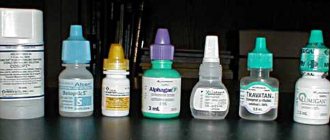Directions for use and doses
Levofloxacin eye drops are instilled into the cavity of the conjunctival sac in the amount of 1-2 drops every two hours during the first two days of therapy. Subsequently, the frequency is reduced to four times a day (for 3-7 days). The duration of treatment is a week. If at the same time the doctor prescribed another drug for topical application, then the interval between medications should be 15 minutes. To prevent contamination of the vial and solution, avoid contact of the dropper tip with non-sterile surfaces.
The safety of Levofloxacin in newborns for the treatment of gonococcal conjunctivitis and corneal ulcers has not been studied. In elderly people, no dosage adjustment or frequency of administration of the drug is required.
Levofloxacin eye drops 5 mg/ml 5 ml with dropper cap No. 1
Name
Levofloxacin solution (supply) 5 mg/ml 5 ml in pack No. 1
Description
Transparent yellowish-green solution.
Main active ingredient
Levofloxacin
Release form
Eye drops
Dosage
5mg/ml
pharmachologic effect
An antimicrobial drug from the fluoroquinolone group, a levorotatory isomer of ofloxacin. Has a wide spectrum of antibacterial (bactericidal) action. Inhibits bacterial DNA gyrase (mainly in gram-negative bacteria) and topoisomerase IV (mainly in gram-positive bacteria), enzymes responsible for replication, transcription, repair and recombination of bacterial DNA. Causes profound morphological changes in the cytoplasm, cell wall and membrane of bacteria. Levofloxacin is active against the following microorganisms according to the European Committee on Antimicrobial Susceptibility Testing (EUCAST): 1. Usually sensitive microorganisms: – Aerobic gram-positive microorganisms: Staphylococcus aureus (MSSA)*, Streptococcus pneumonia, Streptococcus pyogenes, Viridans group of streptococci; – Aerobic gram-negative microorganisms: Escherichia coli, Haemophilus influenza, Moraxella catarrhalis, Pseudomonas aeruginosa (local strains); – Other microorganisms: Chlamydia trachomatis (treatment of patients with chlamydial conjunctivitis requires concomitant systemic antimicrobial therapy). 2. Microorganisms for which the acquisition of resistance may be a problem: – Aerobic gram-positive microorganisms: Staphylococcus aureus (MRSA)**, Staphylococcus epidermidis; – Aerobic gram-negative microorganisms: Pseudomonas aeruginosa (hospital strains). * Methicillin-sensitive strains of Staphylococcus aureus ** Methicillin-resistant strains of Staphylococcus aureus
Indications for use
Local treatment of superficial bacterial infections of the eye caused by microorganisms sensitive to levofloxacin in adults and children aged 1 year and older. Official guidelines on the appropriate use of antibacterial agents should be taken into account.
Directions for use and doses
For all patients. Instill 1-2 drops into the affected eye(s) every 2 hours up to 8 times a day while awake for the first 2 days, then 4 times a day for the next 3-5 days. The duration of treatment depends on the severity of the disease, the clinical and bacteriological course of the infection. Usually the duration of treatment is 5 days. Elderly patients. No dosage adjustment is required. Children. For children aged 1 year and older, the dosage regimen is the same as for adults. Safety and effectiveness in children under 1 year of age have not been established. Safety and effectiveness in the treatment of corneal ulcers and neonatal blenorrhea have not been studied. Directions for use: For local ophthalmic use. The drug is instilled into the conjunctival sac, after which it is recommended to lightly press the inner corner of the eye to close the nasolacrimal duct or slightly close the eyelids. This may reduce systemic absorption and the risk of systemic adverse effects. When using several ophthalmic drugs for topical use simultaneously, it is necessary to maintain at least a 15-minute interval between instillations. To avoid contamination of the tip of the dropper and the solution, it is not recommended to touch the tip of the dropper to the eyelids and tissues around the eye. Recommendations for the use of bottles with a dropper cap: Before use, carefully read this section and sequentially perform the operations presented below in the text and in Figures 1-6. 1. Remove the bottle from the package. 2. Place the scissors at an angle of 45 degrees to the lid, pick up its lower edge, and with an upward motion, remove the aluminum cap along with the rubber lid. 3. Remove the dropper from the package and place it tightly on the bottle. 4. Turn the bottle strictly vertically to remove the air bubble and wait a few seconds. In the case of a large bubble, return the bottle to its original position, and then slowly repeat the action, gently tapping the bottom of the bottle. 5. Apply instillation by pressing the pipette with your index finger and thumb. 6. Turn the bottle over and close the pipette with a special stopper. Recommendations for using dropper tubes: before using the medicine, remove the protective cap from the dropper tube and cut off the membrane of the body neck with scissors without damaging the threaded part. Turn the body of the dropper tube with the medicine neck down and gently press the body of the dropper tube, using it as a pipette. After using the dose recommended by the doctor or indicated in the instructions for use of the medicinal product, turn the body of the dropper tube over with the threaded part up and screw on the protective cap. Wash your hands before using eye drops. Do not touch the dropper or pipette to your eyes or hands.
Use during pregnancy and lactation
Contraindicated.
Impact on the ability to drive vehicles and other potentially dangerous mechanisms
Due to possible visual impairment that occurs immediately after instillation, you should stop driving and driving potentially dangerous machinery until your vision normalizes.
Precautionary measures
The drug should not be administered subconjunctivally; direct instillation into the anterior chamber of the eye should be avoided. Eye drops contain benzalkonium chloride as a preservative, which can cause eye irritation and change the color of soft contact lenses. Contact of the drug with soft contact lenses should be avoided. You should not wear contact lenses of any type if you have symptoms of bacterial conjunctivitis. Fluoroquinolones for systemic use can cause allergic reactions (accompanied by cardiovascular disorders, swelling of the larynx, pharynx and face, and difficulty breathing) even after a single use. If an allergic reaction to levofloxacin occurs, you should stop using eye drops. Long-term use of levofloxacin in the form of eye drops can lead to the growth of resistant microorganisms, as well as fungi. If the clinical picture worsens or does not improve, the drug should be discontinued and treatment with other drugs should be prescribed.
Interaction with other drugs
No specific interaction studies have been conducted with levofloxacin eye drops. Since the maximum plasma concentration of levofloxacin after topical administration is 1000 times less than after oral administration, interaction effects with other drugs are unlikely.
Contraindications
Hypersensitivity to levofloxacin or to other quinolones, to benzalkonium chloride; pregnancy, lactation period, children under 1 year.
Compound
active substance: levofloxacin (in the form of levofloxacin hemihydrate) – 5 mg/ml excipients: benzalkonium chloride, sodium chloride, disodium edetate, hydrochloric acid 1 M solution, water for injection.
Overdose
An overdose of the drug in the form of eye drops is unlikely. Symptoms: tissue irritation (burning, redness, swelling, pain, lacrimation). Treatment: rinse with clean (tap) water at room temperature; in the presence of severe side effects, use symptomatic therapy.
Side effect
The frequency of side effects is given in the following gradation: very often (? 1/10); often (?1/100,
Storage conditions
In a place protected from light at a temperature not exceeding 25 ° C. Keep out of the reach of children. Store the opened bottle in a place protected from light at a temperature of 15 ° C to 25 ° C for 4 weeks.
special instructions
Levofloxacin eye drops can only be used topically. The solution cannot be injected into the anterior chamber of the eye or subconjunctivally.
The solution contains benzalkonium chloride, which is a preservative. In this regard, there is no need to use the drug when wearing hydrophilic contact lenses, because in this case eye irritation may occur. If there are signs of bacterial conjunctivitis, then contact methods of refractive correction should be completely abandoned.
Due to the fact that after instillation of the medicine, a temporary decrease in vision may occur, it is not recommended to engage in potentially hazardous activities during this period, in particular, driving a car.
Due to the fact that systemic fluoroquinolols can lead to serious allergic reactions even after a single dose, Levofloxacin eye drops should be discontinued if signs of allergy and hypersensitivity occur.
If you use the drug for a long time, there is a high probability of resistance developing in microorganisms, as well as the growth of fungal flora. If there is a decrease in the effectiveness of Levofloxacin eye drops or an increase in clinical symptoms, then it is necessary to change the medicine to another antibiotic.
Levofloxacin-Optic
Levofloxacin is the L-isomer of the racemic drug substance ofloxacin. The antibacterial activity of ofloxacin relates mainly to the L-isomer. As an antibacterial drug of the fluoroquinolone class, levofloxacin blocks DNA gyrase (topoisomerase II) and topoisomerase IV, disrupts supercoiling and cross-linking of DNA breaks (deoxyribonucleic acid), suppresses DNA synthesis, causes profound morphological changes in the cytoplasm, cell wall and membranes.
Mechanism of resistance development
Resistance to levofloxacin can develop primarily through two main mechanisms, namely: a decrease in the intracellular concentration of the drug or changes in the targets of the drug.
Changes in the targets of the two bacterial enzymes DNA gyrase and topoisomerase IV are the result of mutations in the chromosomal genes encoding DNA gyrase ( gyrA
and
gyrB
) and topoisomerase IV (
pa rC
and
parE
;
grlA
and
grlB
in
Staphylococcus aureus
).
Drug resistance due to low intracellular concentration develops as a result of changes in the porin channel system of the outer cell membrane, which leads to a decrease in fluoroquinolone entry into gram-negative bacteria, or from efflux pumps.
Efflux-mediated resistance has been described in pneumococci
(
PmrA
),
staphylococci
(
NorA
), anaerobic and gram-negative bacteria.
Plasmid-mediated quinolone resistance (defined based on the qnr
) was found against
Klebsiella pneumoniae and Escherichia coli.
The development of cross-resistance between fluoroquinolones is possible.
Single mutations may not lead to clinical resistance, but multiple mutations cause clinical resistance to all drugs in the fluoroquinolone class. Alterable outer membrane porins and efflux systems can have broad substrate specificity, affecting multiple classes of antibacterial agents and leading to multiple resistance.
Installed in vitro
and has been confirmed in clinical studies to be effective against gram-positive aerobes -
Enterococcus faecalis, Staphylococcus aureus
(methicillin-sensitive strains),
Staphylococcus epidermidis
(methicillin-sensitive strains),
Staphylococcus saprophyticus, Streptococcus pneumoniae
(including multi-resistant strains - MDRSP),
Streptococcus pyogenes
;
gram-negative aerobes - Enterobacter cloacae, Escherichia coli, Haemophilus influenzae, Haemophilus paraintluenzae, Klebsiella pneumoniae, Legionella pneumophila, Moraxella catarrhalis, Proteus mirabilis, Pseudomonas aeruginosa, Serratia marcescens
and other microorganisms -
Chlamydia pneumoniae, Mycoplasma pneumoniae
.
Against most (≥90%) strains of the following microorganisms in vitro
minimal inhibitory concentrations of levofloxacin have been established (2 mcg/ml or less), however, the effectiveness and safety of the clinical use of levofloxacin in the treatment of infections caused by these pathogens has not been established in adequate and well-controlled studies: gram-positive aerobes -
Staphylococcus haemolyticus, Streptococcus
(group C/F ),
Streptococcus
(group G),
Streptococcus agalactiae, Streptococcus milleri, Streptococcus viridans
;
gram-negative aerobes - Acinetobacter lwoffii, Acinetobacter baumannii, Bordetella pertussis, Citrobacter (diversus) koseri, Citrobacter freundii, Enterobacter aerogenes, Enterobacter sakazakii, Klebsiella oxytoca, Morganella morganii, Pantoea (Enterobacter) agglomerans, Proteus vulgaris, Providencia rettgeri, Providencia s tuartii, Pseudomonas fluorescens
;
gram-positive anaerobes - Clostridium perfringens.
Sensitive microorganisms
: aerobic gram-positive microorganisms -
Corynebacterium diphtheriae, Enterococcus spp
., including
Enterococcus faecalis, Listeria monocytogenes, Staphylococcus spp.
(coagulase-negative methicillin-sensitive/leukotoxin-containing/moderately sensitive strains), including
Staphylococcus aureus
(methicillin-sensitive strains),
Staphylococcus epidermidis
(methicillin-sensitive strains),
Streptococcus spp.
groups C and G,
Streptococcus agalactiae, Streptococcus pneumoniae
(penicillin-sensitive/moderately sensitive/resistant strains),
Streptococcus pyogenes, Streptococcus spp.
viridans group (penicillin-sensitive/resistant strains);
aerobic gram-negative microorganisms - Acinetobacter spp.,
including
Acinetobacter baumannii, Acinetobacillus actinomycetecomitans, Citrobacter freundii, Eikenella corrodens, Enterobacter spp.
, including
Enterobacter aerogenes, Enterobacter agglomerans, Enterobacter cloacae, Escherichia coli, Gardnerella vaginalis, Haemophilus ducreyi, Haemophilus influenzae
(ampicillin-sensitive/resistant strains),
Haemophilus parainfluenzae, Helicobacter pylori, Klebsiella spp
., including
Klebsiella oxytoca, Klebsiella pneumonia e, Moraxella catarrhalis
(beta-lactamase-producing and non-beta-lactamase-producing strains),
Morganella morganii, Neisseria gonorrhoeae
(penicillinase-producing and non-penicillinase-producing strains),
Neisseria meningitidis, Pasteurella spp
., including
Pasteurella canis, Pasteurella dagmatis, Pasteurella multocida, Proteus vulgaris, Providencia spp. , including Providencia rettgeri, Providencia stuartii, Pseudomonas spp
., including
Pseudomonas aeruginosa, Serratia spp
., including
Serratia marcescens, Salmonella spp
.;
anaerobic microorganisms - Bacteroides fragilis, Bifidobacterium spp., Clostridium perfringens, Fusobacterium spp., Peptostreptococcus spp., Propionibacterium spp., Veilonella spp
.;
other microorganisms - Bartonella spp., Chlamydia pneumoniae, Chlamydia psittaci, Chlamydia trachomatis, Legionella pneumophila, Legionella spp., Mycobacterium leprae, Mycobacterium tuberculosis, Mycoplasma hominis, Mycoplasma pneumoniae, Rickettsia spp., Ureaplasma urealyticum.
Moderately sensitive microorganisms (MIC more than 4 mg/l)
: aerobic gram-positive microorganisms -
Corynebacterium urealyticum, Corynebacterium xerosis, Enterococcus faecium, Staphylococcus epidermidis
(methicillin-resistant strains),
Staphylococcus haemolyticus
(methicillin-resistant strains);
aerobic gram-negative microorganisms - Burkhoideria cepacia, Campylobacter jejuni, Campylobacter coli
;
anaerobic microorganisms - Bacteroides thetaiotaomicron, Bacteroides vulgatus, Bacteroides ovatus, Prevotella spp., Porphyromonas spp.
Resistant microorganisms (MIC more than 8 mg/ml)
: aerobic gram-positive microorganisms -
Corynebacterium jeikeium, Staphylococcus aureus
(methicillin-resistant strains), other
Staphylococcus spp
.
(coagulase-negative methicillin-resistant strains); aerobic gram-negative microorganisms - Alcaligenes xylosoxidane
;
other microorganisms - Mycobacterium avium.
Minimum inhibitory concentrations of levofloxacin for certain microorganisms
| Microorganism | Sensitive, mg/ml | Resistant, mg/ml |
| Pseudomonas spp. | ≤1 | >2 |
| Staphylococcus spp. | ≤1 | >2 |
| Streptococcus | ≤1 | >2 |
| Streptococcus pneumoniae | ≤1 | >2 |
| Haemophilus influenzae | ≤1 | >1 |
| Moraxella catarrhalis | ≤1 | >2 |
Activity of levofloxacin in vitro
approximately 2 times higher than for ofloxacin against representatives
of Enterobacteriaceae, Pseudomonas aeruginosa
and gram-positive microorganisms.
In the case of using levofloxacin in the treatment of chlamydial diseases of the organs of vision, concomitant therapy is required.
The degree of sensitivity of microorganisms to levofloxacin may have significant geographical differences.
The maximum concentration of levofloxacin achieved using 0.5% eye drops is more than 100 times the minimum inhibitory concentration (MIC) of levofloxacin for sensitive microorganisms.


